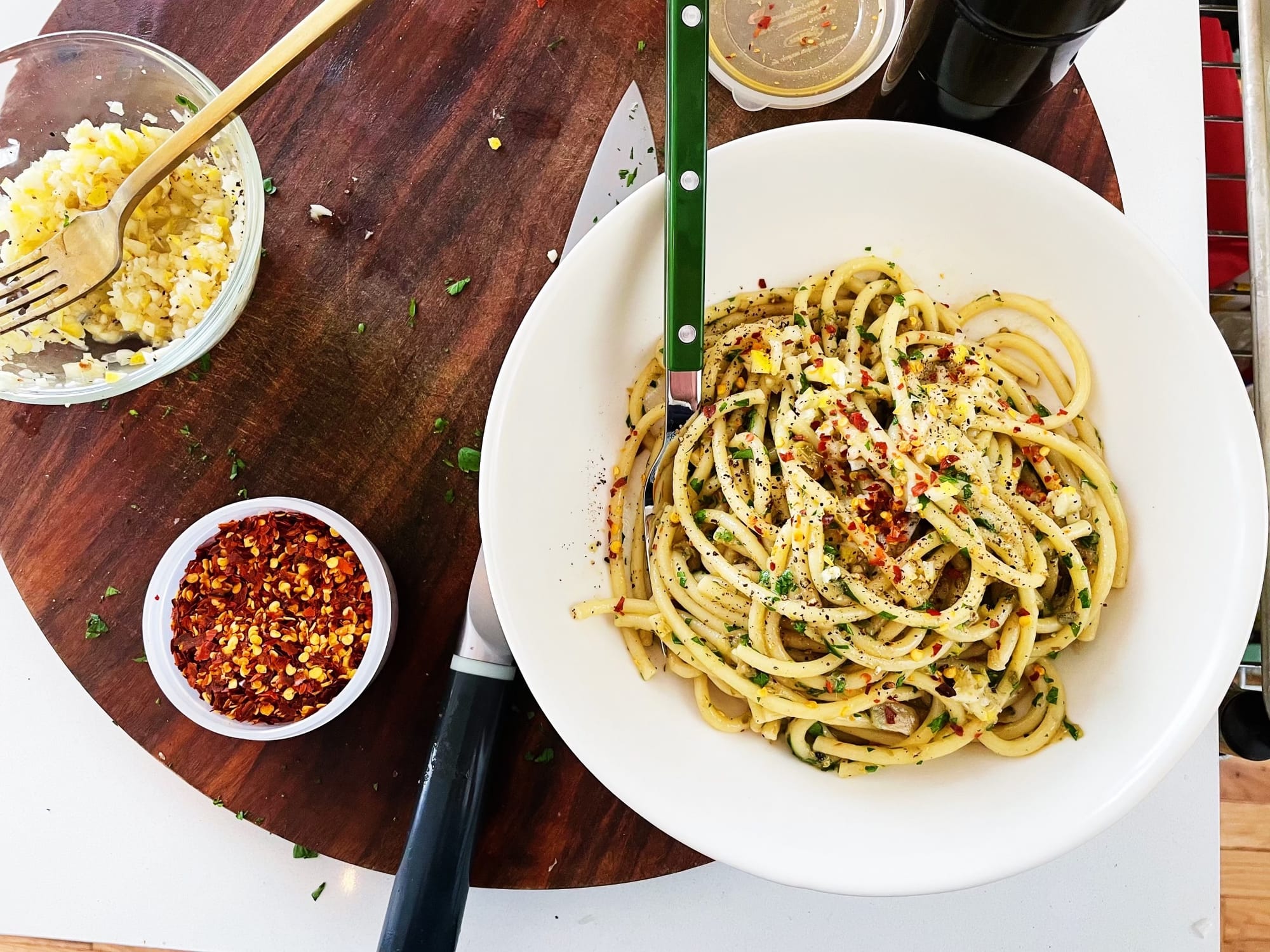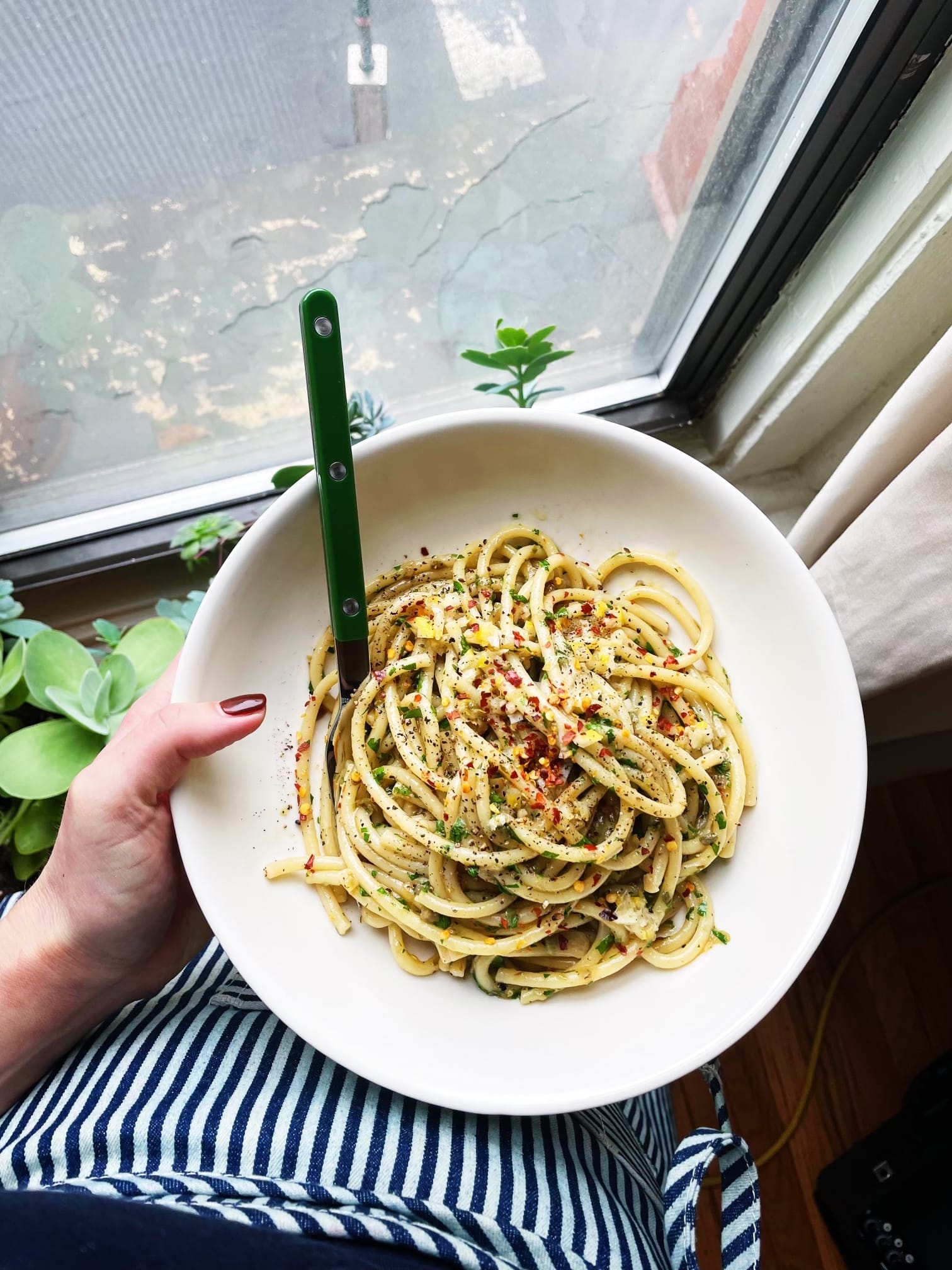
Pantry Pasta! Pasta from your pantry!
Home Movies Tuesday!
It is with great satisfaction and a touch of embarrassment that I present to you my third Caesar-ish recipe in a seven-day stretch (see soup here, salad here), and my third BEIGE Home Movie Recipe since we started back up in February. All of this is a coincidence, but it does please my virgo brain to have themed coordination even if it’s a total accident. Maybe it’s the world, maybe it’s the weather, but I’m just feeling like we should just lean in, let the beige wash over us.
Think of this episode of Home Movies as the pasta version of Brothy Beans. Pantry Pasta is less of a recipe, more of an idea. Less about the exact measurements and more about absorbing the notion that when you’re stocking your pantry with things you love to eat, you can always have pasta even when there’s nothing in the fridge. For these intents and purposes I am excluding “canned tomato products” from this list, because to me while YES stored in the pantry, they are their own thing (ingredients for a tomato sauce).

The Video

As I mentioned in the video, this is my pantry pasta, as in: this is the pasta I make with ingredients from MY pantry, and this is also MY pantry pasta that I make with those ingredients—you know? Meaning, both YOUR pantry and YOUR pantry pasta might look a little different, which as always, is encouraged.
Things to take away from this episode no matter what you’re using:
Pantry pasta is not quiet, pantry pasta wants to be loud. If you have two anchovies to use up, sure, throw them in. But for actual impact, you’re gonna want the whole tin, my friends. Half a garlic clove will never do anyone any favors when we’re talking 12-16 ounces of pasta. Small measurements of things not welcomed in my pantry pasta! Big impact measurements only.
Olive oil, kosher salt, freshly ground black pepper and crushed red pepper flakes are a given. They should always be on hand! Check your supplies, stock up if you’re running low. These four ingredients could make a pantry pasta, if they needed! I’ve done it.
If you don’t like anchovies, use capers. If you don’t have capers, crushed, finely chopped olives are great. If you don’t like whole lemon, simply use the juice and zest, but please I think you’ll like it. If you don’t like capers, anchovies, olives or whole lemon, there are a million recipes in the world that don’t feature any of those things—this is not one of them.
Other pantry items that I did not feature that would be nice here:
Fish sauce. Just a few dashes is an excellent stand-in for anchovies.
Soy sauce or Worcestershire sauce. A small amount added to the pasta used almost like salt.
Chili crisp. Good for adding in just before pasta to toast it even further.
Panko bread crumbs (seen here in clam pasta!)
Crushed, toasted nuts, almonds and walnuts especially (seen here in zucchini pasta salad)
Sardines. Not to be used in place of anchovies (they don’t melt down/cook/taste the same)—but to be used afterwards, for last minute tossing through.
Preserved lemon. Use like the whole lemon here, or add with shallot to cook into a paste.
Gochujang. If you have it, I like using almost like tomato paste. Depending on spiciness level, they are not a 1:1 swap—start with half the amount of tomato paste you’d use.
White wine vinegar. Very Sicilian/Venetian to season pasta with vinegar instead of lemon. While lemons are truly always present in my house (I sleep on a pillow made of lemons), in the event I’m without, a tiny splash can really make a difference.
Other things I have on hand as if it were a part of my pantry
Lemons. Buy by thee bag, not each. Saves $$ to buy more at a time, less of a chance you’ll run out. I keep them on the counter, unless I know I’m not cooking often that week, then I toss into the fridge.
Parmesan. Buy it by the hunk. It stays fresher longer that way, plus you’ll be so glad you always have a hunk of Parmesan around (it keeps forever if wrapped in parchment). It’s also good as a snack, and anything you can cook with AND snack on means I always want it around. Really is the perfect food.
Also not exactly low on the perishability scale, but I always always always have a bunch of parsley on hand. It’s mutable and aggregable in the best way. It goes with everything, is always welcomed, always happy to see it, always improves nearly anything. If I’m struggling to make my way through it, I throw it in my smoothies (I make smoothies now). The stems, the leaves, use it all.
It goes without saying, if you have non-pantry items you’d like to include: greens, a half bulb of fennel, shrimp, a few strips of bacon, eggs to crisp up and use for a topping—go for it. The pantry pasta does not have to be constrained by its name.
Olive oil
— alison roman (@alisoneroman) 7:35 PM ∙ Mar 12, 2020
Lemons
Fresh herbs (parsley/cilantro/dill)
Alliums (garlic/shallot/onion)
Dried or canned beans/chickpeas
Canned tomatoes/tomato paste
Crushed red pepper flakes
Anchovies
Parmesan
Soy sauce
Eggs
Yogurt/labne/sour cream
Pickles/kimchi for snacking
Pantry Pasta
serves 4
Remember these are suggestions! This is what I made that day and was, if I do say so myself, very pleased with. Would strongly recommend anyone follow this recipe, but equally recommended you going rogue and adding your own pantry flair.
Ingredients
- 4-6 garlic cloves
- 1 lemon, halved
- ⅓ cup olive oil
- 2 tablespoons butter or olive oil
- 2 large shallots or 1 medium onion, finely chopped
- 1 2 oz. tin anchovies
- 2 tablespoons capers, finely chopped
- Crushed red pepper flakes
- 12 ounces whatever pasta you’ve got
- 1 cup herbs such as parsley, chives, tarragon or even dill, finely chopped
- Parmesan or pecorino for serving, optional
Preparation
1. Get a large pot of water on to boil, season it heavily with salt.
2. Finely chop one garlic clove and place in a small bowl; set aside. Thinly slice remaining garlic cloves; set aside.
3. Finely chop half of the lemon (making sure to remove any seeds), add to the bowl with the finely chopped garlic and season with salt and pepper; set aside, this is for topping the pasta later. Set the rest of the lemon aside for squeezing over.
4. Heat olive oil and butter (if using) in a large skillet over medium heat. Add shallots and thinly sliced garlic and season with salt and pepper. Cook, stirring occasionally until they’re lightly browned at the edges, but mostly starting to melt into each other into a sort of translucent paste, 8–10 minutes. Add anchovies, capers, and crushed red pepper flakes, stirring to encourage the anchovies to melt into the oil. Cook, stirring occasionally, until you’ve got a thick, concentrated paste, just a few minutes. Taste it—it should be almost too intense, too salty, and definitely not “saucy” (you dilute the paste with pasta water). Set this aside (you can make this a few hours ahead of time—a few days, if you wanted. If I were smart, I’d figure out how to bottle this stuff so you can use it any time).
5. Cook pasta until just before al dente. Pre-al dente, even. Using tongs, transfer the pasta to the skillet along with about a cup of pasta water (alternatively, drain the pasta, just don’t forget to save at least 1 ½ cups pasta water—we are using it, I promise).
6. Cook the pasta, stirring often (I like tongs for this, too), until the pasta is al dente and the sauce has thickened, 3–5 minutes. Add herbs and toss to coat, adding a splash or two of pasta water if you feel like it needs it. Despite the original mixture not being “saucy,” your end result should most definitely be saucy.
7. To serve, divide among bowls (or eat out of skillet), squeezing lemon juice over and scattering over some of that lemon-garlic mixture.


Discussion